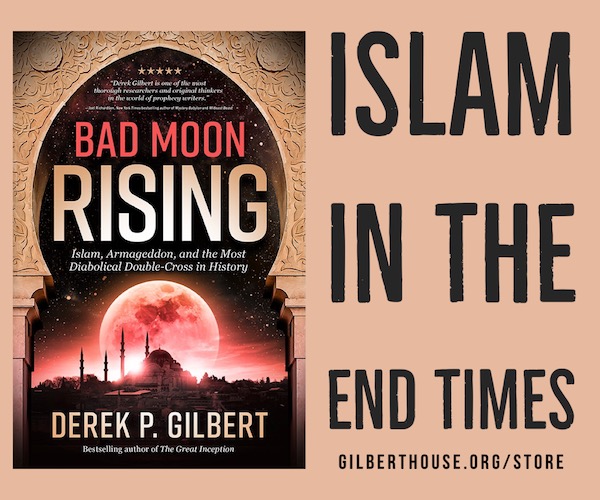As we noted in the introduction to this book, God took the rebel gods by surprise with His act of self-sacrifice at Calvary. Paul put it this way: “None of the rulers of this age understood this, for if they had, they would not have crucified the Lord of glory.”[1]
The Greek word translated “rulers,” archontōn, could refer to the Jewish and Roman officials who sent Jesus to the cross, but in context, it’s more likely that Paul meant principalities and powers—the supernatural sons of God who’d been in a state of rebellion against their Creator for more than three thousand years.
The beauty of this spiritual jujitsu move is that Jesus telegraphed it with the Parable of the Tenants:
And he began to speak to them in parables. “A man planted a vineyard and put a fence around it and dug a pit for the winepress and built a tower, and leased it to tenants and went into another country. When the season came, he sent a servant to the tenants to get from them some of the fruit of the vineyard. And they took him and beat him and sent him away empty-handed. Again he sent to them another servant, and they struck him on the head and treated him shamefully. And he sent another, and him they killed. And so with many others: some they beat, and some they killed. He had still one other, a beloved son. Finally he sent him to them, saying, ‘They will respect my son.’ But those tenants said to one another, ‘This is the heir. Come, let us kill him, and the inheritance will be ours.’ And they took him and killed him and threw him out of the vineyard. What will the owner of the vineyard do? He will come and destroy the tenants and give the vineyard to others.”
Mark 12:1–9 (ESV)
The priests, scribes, and elders assumed that Jesus was talking to them. He was, of course, but on a deeper level, the parable was directed at the spirits behind the Jewish religious authorities. The tenants in Jesus’ story were the “sons of God” (Hebrew bene ha-elohim) placed over the nations after the Tower of Babel incident. The servants sent by the vineyard’s owner were the prophets, none of whom lived easy lives. The son and heir, of course, was the Messiah, Jesus.
Even though He told them exactly what would happen, the “cosmic powers over this present darkness” could not resist sending Him to the cross.
Things didn’t go the way they planned. Jesus took the opportunity of His physical death to explain a few things to the first generation of rebels, the Watchers who’d been locked up in Tartarus for the Mount Hermon rebellion.
He went and proclaimed to the spirits in prison, because they formerly did not obey, when God’s patience waited in the days of Noah.
1 Peter 3:19b–20a (ESV)
The Greek word translated “proclaimed” is sometimes rendered “preached” in English Bibles, but the sense of the verse is more forceful than just preaching. In a nutshell, Jesus visited the Watchers in the abyss to explain what had just taken place in Jerusalem: He was dead in the flesh, and that was exactly what He wanted to happen.
In other words, to paraphrase Dr. Michael Heiser: “Thank your minions for helping me complete my mission. By the way, I’m getting out of here at dawn of the third day—and you’re still dead.”
World history suggests that the gods of the nations have been at war as much with each other as they’ve been with their Creator. The shock of the Resurrection and the improbable survival of the early church despite efforts by Rome and Jerusalem to stamp it out forced the pagan gods to admit they’d been completely outplayed. The clock was ticking and their backs were against the wall. It was time to try something desperate—setting aside differences for a joint effort to build a counter-religion to the growing faith in Jesus Christ.
Let’s meet the colleagues of the moon-god as they were described in the texts left behind by their followers, from the time writing was invented through the period of the early Christian church.
One of the oldest gods in the Mesopotamian pantheon has a name that’s led to a lot of confusion over the years about who he is and where his cult began. That’s because the name of this deity became a generic word for “god” in multiple languages, including some still spoken today. We’re referring to “the” god, variously known as El, Ilu, Enlil, Dagan (later Dagon), and Assur in the ancient Near East.
Among the earliest Amorites who came into contact with the Akkadians and Sumerians, the two most popular deities were the moon-god and “the” god. This is easy to document; we just need to look at the Amorite names that appear in records archaeologists have found and translated from ancient Sumer and Akkad.
If we then take a look at the 43 most popular Amorite names (in this case: Amorite names occurring three times or more). We can see immediately the moon-god Erah [Note: alternate spelling of Yarikh] and El (‘god’) are the two most popular (and only) theophoric elements in these early OB Amorite personal names. This is a striking parallel with the Akkadian personal names. This parallel pleads against the “Amorites” as newcomers, because such a phenomenon is typically the result of long-term contact and/or acculturation.[2]
The period covered in that study is the time of Abraham and Isaac, texts dated to between 1900 BC and 1791 BC.[3] Considering the number of gods in the Mesopotamian pantheon, it’s significant that Amorites in Akkad and Sumer during the lifetime of Abraham only honored two of them.
Why these two? Since we’ve already discussed the moon-god in some detail, let’s deal with his father, “the” god.
First of all, just like the moon-god, the deity called El was known by a number of different names over the centuries. A trilingual god list from the Amorite kingdom of Ugarit, which comes from the time of the judges, offered this handy equation: Enlil = Kumarbi = El.[4]
Kumarbi was a god of the Hurrians, an Indo-European people who lived in eastern Anatolia and northern Mesopotamia, roughly the area occupied today by the Kurds in Iraq, Syria, and Turkey, extending as far north as modern Armenia. His name may derive from an ancient town in northern Syria, meaning “he of Kumar,” a site identified with modern Kīmār about twenty-five miles northwest of Aleppo.[5]
The Hurrian myth also locates Kumarbi in the western part of the Khabur River triangle, near the river along the border between Turkey and Syria, and the ancient city of Tuttul, which was near the modern city of Raqqa. Tuttul was a major cult center of Dagan,[6] providing evidence that the first-generation gods of the ancient Near East, from east to west, were one and the same: Enlil = Dagan = Kumarbi = El.
This is an important link in our chain, because connecting El to Enlil helps untangle the etymology of the Enlil’s name.
Scholars used to believe “Enlil” was a combination of the Sumerian words en (“lord”) and líl (“air/wind” or “storm”).[7] But it turns out that’s too simple. The texts about Enlil don’t yield any of the characteristics you’d expect from a wind- or storm-god.[8] Based on his identification with El, Kumarbi, and Dagan, Enlil should be understood as “a universal god who controls different spheres and domains, different areas without any defined specialization”[9]—in other words, Enlil was “the” god.
That makes the etymology of Enlil’s name easier to grasp. Rather than Sumerian en + líl, it’s more likely derived from a Semitic (i.e., non-Sumerian) language, il-ilī, meaning “god of all the gods.”[10]
That certainly fits the character of Enlil, El, Dagan, and Kumarbi in their respective pantheons. All of them were considered creators of the world, described by epithets like “father of the gods,” “great mountain,” “ancient one,” and so on.
All of them, to people in the ancient world, bridged the gap between time immemorial and the present day. In each case, “the” god had assumed kingship over the pantheon by replacing a primordial deity who represented the sky or heaven. El, Kumarbi, and Dagan supplanted Anu, while El took the place of Šamêm (“Heaven”).[11] In the case of Kumarbi, the confrontation with his father, Anu, was particularly violent; in the fight for control of the universe, Kumarbi castrated Anu—with his teeth.
This detail links Kumarbi to Kronos of Greek mythology, who likewise castrated his father, Ouranos, although Kronos used an adamantine sickle. In turn, the king of the Titans was identified by Greek and Roman historians with Saturn and the Phoenician god Baal-Hammon, who was infamous for the tophet at Carthage, a burial site for very young children sacrificed and burned as offerings to the god—which suggests a connection to another Semitic god, Molech.
Before we get ahead of ourselves, let’s recap: It appears that the same entity, called by different names, occupied the same slot in the pantheons of multiple civilizations. Specifically, Enlil (Sumer/Akkad), Dagan (Amorites of Syria), El (Canaan), Kumarbi (Hurrians and Hittites), Kronos (Greece), Saturn (Rome), and Baal-Hammon (Phoenicians) were essentially one and the same.
Recent discoveries point to northern Syria and southern Türkiye, especially the region near Aleppo, Antioch (modern Antakya), and the mountains and valleys around them as key to the history of “the” god. Baal-Hammon, Saturn, and Kronos were the names of this god in the western Mediterranean, and they emerged after the time of David in the first millennium BC. The older names are found farther east.
Kumarbi of the Hurrians was linked to a town between Aleppo and Antioch; El was probably worshiped at Mount Zaphon before it became Baal’s mount of assembly;[12] the name of their Phoenician equivalent, Baal-Hammon, means “lord of the Amanus,”[13] which are the mountains just to the north of Zaphon; Dagan was the chief deity along the middle Euphrates in what is now Syria; and since the name “Enlil” appears to be Semitic rather than Sumerian, it’s possible that he, too, began his career in this part of northern Mesopotamia.
In other words, rather than emerging from Sumer in the south, as Mesopotamian civilization is assumed to have done, “the” god Enlil may have been imported to Sumer from lands far to the northwest. In a very broad sense, that includes Jebel Bishri, the origin point of the Amorites (and Jebel Diddi, a mountain apparently named for the Amorite Ditanu tribe that is the origin of the name of the elder gods of the Greeks and Romans, the Titans), Mount Hermon, Mount Zaphon, and the Amanus range—all mountains connected to the rebel gods.
Why? What made that area a hot spot for two of the most important rebel gods, Enlil/El/Dagan (“the” god) and Hadad (Baal), the storm-god? We can only guess. But the flow of history from north to south makes sense from a biblical perspective—that’s the direction the descendants of Noah migrated as they moved south from the mountains of Ararat in present-day Armenia and Türkiye.
[1] 1 Corinthians 2:8 (ESV).
[2] Rients de Boer, “Amorites in the Early Old Babylonian Period.” Dissertation, Leiden University (2014), 69. http://hdl.handle.net/1887/25842, retrieved 11/8/18.
[3] Ibid.
[4] Lluis Feliu and Wilfred G. E. Watson. The God Dagan in Bronze Age Syria. (Leiden: Brill, 2003), 299.
[5] Michael C. Astour, “Semitic Elements in the Kumarbi Myth.” Journal of Near Eastern Studies, Vol. 27, No. 3 (July, 1968), 172.
[6] Feliu, op. cit., 303.
[7] Lluis Feliu, “Concerning the Etymology of Enlil: the An=Anum Approach.” Aula Orientalis-Supplementa 22 (2006), 229.
[8] Ibid., 246.
[9] Ibid.
[10] Ibid., 230.
[11] Frank Moore Cross, Canaanite Myth and Hebrew Epic: Essays in the History of the Religion of Israel(Cambridge: Harvard University Press, 1973), 41.
[12] Lipiński, op. cit., 64.
[13] Cross, op. cit., 26.

